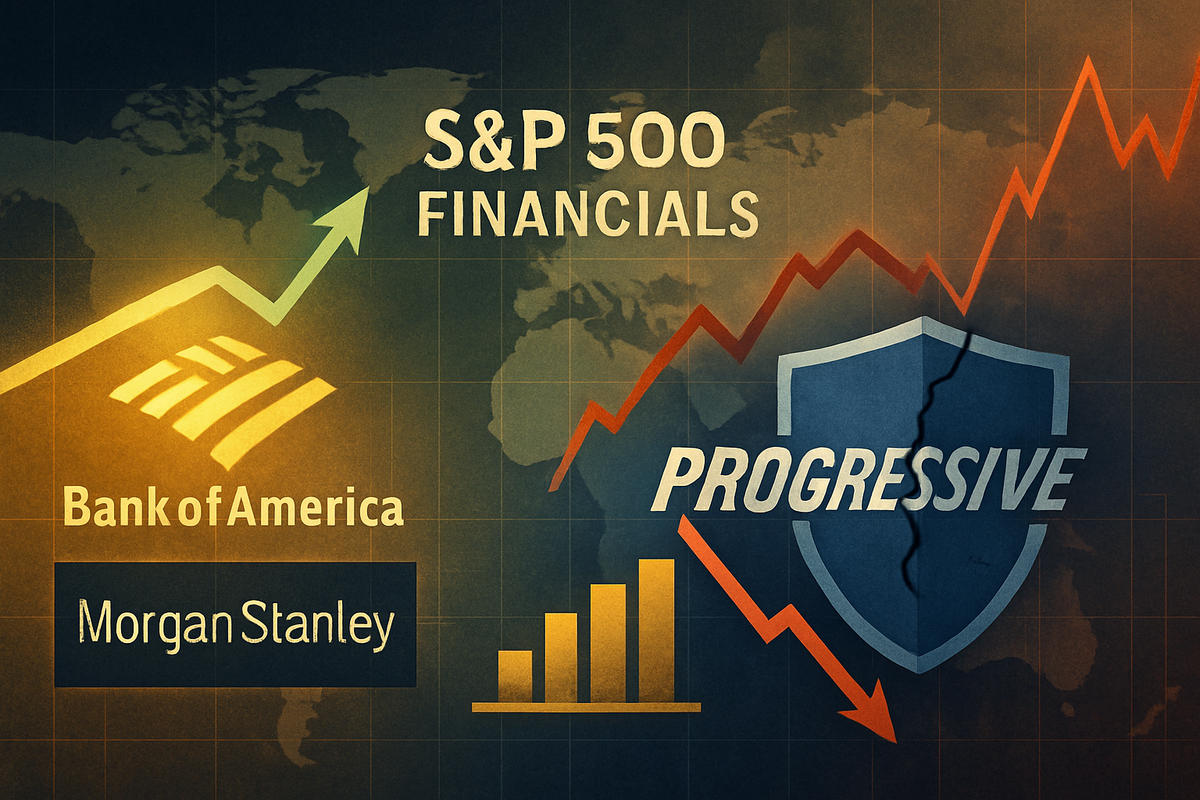
The S&P 500 Financials sector is currently experiencing a period of significant divergence, as robust third-quarter 2025 earnings from banking titans Bank of America (NYSE: BAC) and Morgan Stanley (NYSE: MS) injected a wave of optimism, while a disappointing report from insurance giant The Progressive Corporation (NYSE: PGR) sent its shares tumbling. This mixed performance, unfolding against a backdrop of fluctuating geopolitical tensions, paints a complex picture for investors, highlighting both the resilience of certain financial segments and the vulnerabilities within others. The contrasting results underscore the nuanced economic landscape as the market assesses corporate health and future growth trajectories.
The immediate implications of these varied earnings reports are a testament to the market's selective appetite for risk and reward. While the strong showings from major banks were instrumental in stabilizing and even propelling broader market indices after initial jitters caused by renewed U.S.-China trade tensions, Progressive's substantial earnings miss served as a stark reminder of sector-specific challenges. This bifurcated performance suggests that while investor sentiment towards the financial sector remains largely bullish, a deeper dive reveals that not all players are benefiting equally from the prevailing economic conditions, prompting a careful re-evaluation of sub-sector strengths and weaknesses.
Detailed Coverage: A Tale of Two Financial Worlds
The third quarter of 2025 proved to be a banner period for some of the nation's largest banks. Bank of America (NYSE: BAC), reporting on October 15, 2025, significantly exceeded analyst expectations, announcing a net income of $8.5 billion – a 23% year-over-year increase. Its diluted earnings per share (EPS) surged 31% to $1.06, comfortably surpassing estimates. Revenue climbed 11% to $28.1 billion, driven by a potent combination of higher net interest income, robust investment banking fees, and strong trading results. Notably, investment banking fees alone saw a remarkable 47.5% year-over-year increase, signaling a vibrant deal-making environment. The market reacted positively, with Bank of America's stock rising 5.26% following the announcement.
Similarly, Morgan Stanley (NYSE: MS) delivered an impressive performance for Q3 2025, with EPS reaching $2.80, well above consensus estimates. The firm's revenue hit $18.22 billion, also surpassing forecasts, and net income applicable to Morgan Stanley soared 45% year-over-year to $4.61 billion. This strong profit growth was primarily fueled by elevated fees from investment banking activities, including advising on mergers and acquisitions and facilitating stock and debt issuances. The company's Wealth Management division continued its trajectory as a key growth driver, with total client assets reaching an impressive $7.05 trillion. Morgan Stanley's shares also saw a significant positive bump, climbing 6.22% in regular trading.
In stark contrast, The Progressive Corporation (NYSE: PGR) faced a challenging quarter. The insurer reported Q3 GAAP EPS of $4.45, falling considerably short of Wall Street's expectations. Operating revenues of $22.2 billion also missed estimates. A significant factor contributing to this miss was a substantial $950 million charge taken against Q3 earnings, stemming from Progressive's Florida auto insurance unit exceeding the state's statutory profit limits. This required the company to credit profits back to Florida personal auto policyholders. While overall quarterly net income rose 12% to $2.62 billion, net income for September alone dropped dramatically by 48% year-over-year. Furthermore, Progressive's combined ratio, a critical measure of an insurer's profitability, worsened to 89.5% for the quarter and notably to 100.4% in September, indicating that costs outstripped premiums earned during that month. Progressive's stock responded negatively, tumbling 7.9% in trading following its preliminary earnings report.
The broader market initially experienced a "whipsaw" week in mid-October 2025. Major indices slipped on October 14, despite the wave of robust bank earnings and hopes for Federal Reserve interest rate cuts, largely due to an escalation in U.S.-China trade tensions. However, markets demonstrated resilience, staging a notable rebound on October 15 as signs emerged of potential de-escalation in the trade relationship. The strong bank earnings from institutions like Bank of America and Morgan Stanley, coupled with expectations of supportive monetary policy, were seen as signals of underlying corporate strength, contributing significantly to the market's recovery after initial geopolitical jitters.
Winners and Losers: A Shifting Landscape
The recent earnings season clearly delineates the winners and losers within the S&P 500 Financials sector. Bank of America (NYSE: BAC) and Morgan Stanley (NYSE: MS) emerge as significant winners, demonstrating the robust health of diversified banking and investment banking segments. Their strong performance, driven by increased net interest income, burgeoning investment banking fees, and resilient wealth management divisions, positions them favorably for continued growth. These results not only bolster their individual share prices but also enhance their capacity for strategic investments, potential dividend increases, and share buybacks, further rewarding shareholders. Their success suggests a favorable operating environment for large, well-capitalized financial institutions, benefiting from stable credit quality and active capital markets.
Conversely, The Progressive Corporation (NYSE: PGR) finds itself in the "loser" category this quarter. The substantial charge related to Florida's statutory profit limits highlights the unique regulatory and operational challenges faced by property and casualty insurers, particularly in volatile markets. A worsening combined ratio, especially the figure for September, indicates potential pricing pressures or increased claims costs that could erode future profitability. This stumble might put pressure on Progressive to reassess its underwriting strategies, pricing models, and geographic exposure, especially in states with stringent regulatory oversight. For investors, this signals increased risk and potential for downward revisions in future earnings forecasts, impacting stock performance and investor confidence.
The ripple effects of these divergent performances are likely to be felt across the financial sector. Strong bank earnings from leaders like Bank of America and Morgan Stanley could uplift sentiment for other major banks and capital markets firms, such as JPMorgan Chase (NYSE: JPM) and Goldman Sachs (NYSE: GS), as investors infer a positive operating environment for the industry as a whole. Conversely, Progressive's struggles could cast a shadow over the broader insurance industry, particularly property and casualty insurers. Competitors like Allstate (NYSE: ALL) or Travelers Companies (NYSE: TRV) might face increased scrutiny regarding their own regulatory exposures, claims trends, and profitability metrics, leading to potential re-ratings or shifts in investor preference within the insurance sub-sector.
Wider Significance: Navigating Macroeconomic Currents
These mixed earnings reports are more than just individual company performances; they are indicative of broader macroeconomic trends and sector-specific dynamics shaping the financial landscape. The strong results from Bank of America and Morgan Stanley underscore the continued strength in capital markets and the benefits of a higher interest rate environment for net interest income, despite hopes for future Fed rate cuts. The resurgence in investment banking fees suggests a healthy appetite for mergers, acquisitions, and public offerings, signaling corporate confidence and accessible capital. Furthermore, the consistent growth in wealth management highlights the ongoing accumulation of wealth and the demand for sophisticated financial advisory services, serving as a stable revenue stream for diversified financial institutions.
Progressive's difficulties, however, point to the persistent challenges within the property and casualty insurance sector. Regulatory pressures, particularly in states like Florida with specific profit limitations, can significantly impact an insurer's profitability. Additionally, the worsening combined ratio could reflect rising claims costs due to factors such as inflation in repair costs, increased frequency or severity of natural disasters, or competitive pricing pressures. This situation fits into a broader trend where insurers are grappling with a complex environment of escalating operational costs and the need to balance competitive premiums with adequate profitability, often under the watchful eye of state regulators.
The initial market volatility caused by U.S.-China trade tensions, quickly followed by a rebound driven by strong financial earnings, highlights the market's current dual focus: geopolitical stability and corporate fundamentals. While external shocks can trigger immediate reactions, robust earnings from key sectors like financials can provide an underlying cushion and drive recovery. This event serves as a reminder that while global politics influence short-term sentiment, the underlying health of public companies often dictates the medium-to-long-term trajectory. Historically, periods of mixed sector performance often precede shifts in market leadership, where investors rotate capital from underperforming segments to those demonstrating resilience and growth.
What Comes Next: Strategic Shifts and Emerging Opportunities
Looking ahead, the S&P 500 Financials sector is poised for continued differentiation. In the short term, the strong momentum from major banks like Bank of America and Morgan Stanley is likely to sustain positive investor sentiment towards the diversified banking and capital markets segments. This could lead to further upward revisions in analyst forecasts and continued outperformance relative to other financial sub-sectors. For Progressive, the immediate future will likely involve a focused effort to address the profitability challenges, particularly in highly regulated states. This might include re-evaluating their presence in certain markets, adjusting pricing strategies more aggressively, or seeking regulatory relief where possible.
In the long term, the financial landscape will continue to be shaped by evolving economic conditions, interest rate policies, and technological advancements. Banks that have successfully diversified their revenue streams, particularly into wealth management and advisory services, appear better positioned for sustained growth regardless of interest rate fluctuations. For the insurance industry, the imperative to innovate in claims processing, risk assessment, and customer acquisition will intensify. Progressive, like its peers, may need to invest further in data analytics and AI to optimize pricing and underwriting, potentially exploring strategic partnerships or even divestitures of underperforming units to enhance overall profitability.
Market opportunities may emerge from this divergence. Investors might seek out financial technology (fintech) companies that enable insurers to streamline operations or banks to enhance digital offerings, as both segments look for efficiency and competitive edges. Furthermore, the potential for consolidation in the insurance sector could increase as smaller or struggling players look for strategic exits or stronger partners. Challenges include potential regulatory tightening across the financial sector in response to economic shifts or perceived systemic risks, as well as the ongoing pressure to manage cybersecurity threats and adapt to evolving customer expectations for digital services.
Comprehensive Wrap-Up: A Resilient Yet Complex Market
The third-quarter 2025 earnings season for the S&P 500 Financials sector has delivered a clear message of resilience in some areas, juxtaposed with distinct vulnerabilities in others. The standout performances from Bank of America and Morgan Stanley underscore the robust health of capital markets and diversified banking models, benefiting from strategic growth in investment banking and wealth management. Their results provide a strong foundation for continued sector optimism. However, Progressive's significant stumble serves as a critical reminder of the specific, often regulatory-driven, challenges that can impact individual industries within the broader financial sector.
Moving forward, the market will likely continue to differentiate between financial institutions based on their exposure to various economic drivers and their ability to navigate sector-specific headwinds. Investors should assess not only overall earnings growth but also the underlying drivers of profitability, risk management practices, and adaptability to regulatory changes. The lasting impact of this period will likely be a heightened focus on diversification and operational efficiency within financial firms, as well as a more granular approach by investors when allocating capital across the diverse S&P 500 Financials sector.
In the coming months, investors should closely watch for further clarity on U.S.-China trade relations, the Federal Reserve's stance on interest rates, and subsequent earnings reports for signs of sustained trends or shifts. For the banking sector, continued strength in investment banking pipelines and stable net interest margins will be key. For insurers, signs of improved underwriting profitability, effective claims management, and successful navigation of regulatory landscapes will be crucial indicators of recovery and future growth.
This content is intended for informational purposes only and is not financial advice




